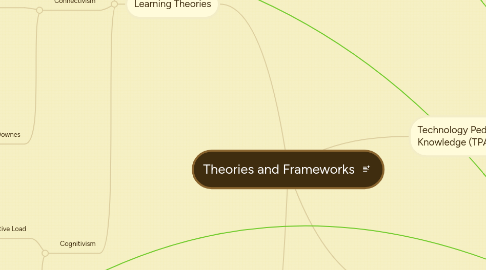
1. Learning Theories
1.1. Constructivism
1.1.1. Teacher is a facilitator
1.1.1.1. Teacher needs to guide learners to reflect on their prior knowledge and determine whether new knowledge compliments or conflicts with their prior knowledge
1.1.1.2. Activities that involve problem solving, making hypothesis, and testing allows for constructive learning
1.1.2. Learning is constructed, new knowledge built upon prior knowledge
1.1.2.1. Students are encouraged to make their own discoveries by integrating prior and new knowledge
1.1.2.2. Students are also encouraged to assess how their understanding is improved by prior/new knowledge, and how their understanding may be impaired by prior knowledge
1.1.3. Learning is active
1.2. Connectivism
1.2.1. Learning occurs when one explores and makes meaningful connections between ideas and concepts
1.2.1.1. Learning can occur in a variety of ways
1.2.1.1.1. Teachers will need to diversify teaching strategies, activities, and even assessments to cater to students' different learner needs, and help them make meaningful connections
1.2.1.1.2. Students can make connections between concepts and their experiences and prior knowledge
1.2.1.1.3. Multimodal
1.2.1.1.4. Visual
1.2.1.1.5. Aural
1.2.1.1.6. Read-Write
1.2.1.1.7. Kinesthetic
1.2.1.2. Connections should be nurtured and maintained
1.2.1.2.1. It is important to continually explore connections that lead us to more current knowledge
1.2.1.2.2. A cycle of knowledge can be created between the individual, organizations, and institutions
1.2.2. Theorists: George Siemens, Stephen Downes
1.3. Cognitivism
1.3.1. Cognitive Load
1.3.1.1. There is limit to the working memory
1.3.1.1.1. Teaching strategies that works with the limited working memory information processing
1.3.1.2. 3 types of cognitive load
1.3.1.2.1. Extraneous
1.3.1.2.2. Intrinsic
1.3.1.2.3. Germane
1.3.1.3. Schemas are created as a result from the working memory interacting with long-term memory
1.3.2. Theorists: Piaget, Gagner, Vygotsky, Bruner
2. Technological Theories
2.1. Social Construction of Technology (SCOT)
2.1.1. Human action shapes technology
2.1.2. Acceptance and Rejection of technology depends on social context
2.1.2.1. Interpretative Flexibility
2.1.2.2. Closure
2.2. Media Ecology
2.2.1. Study of media environments
2.2.2. Interested in the interactions of technology and humans
2.2.3. Theorists: Marshall McLuhan
3. Technology Pedagogy Content Knowledge (TPACK)
3.1. Knowledge that is required by teachers to integrate technology into their teaching
3.2. 3 types of knowledge
3.2.1. Content Knowledge
3.2.2. Pedagogical Knowledge
3.2.3. Technology Knowledge
